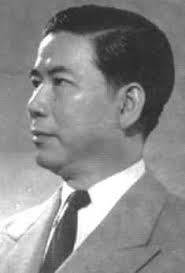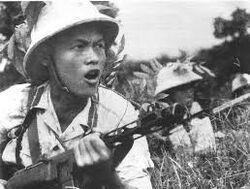What Events Led to the Vietnam War - From Partition to the Viet Cong
After the French defeat at the battle of Dien Bien Phu in 1954, a peace conference was held in Geneva ending the Indonesian War between France and the Viet Minh. In addition to ending hostilities, the country of Vietnam was divided into two separate countries; North Vietnam or the Democratic Republic of Vietnam and South Vietnam or the Republic of Vietnam. Ho Chi Minh and the Vietnamese Communist Party were in control of the north and Ngo Dinh Diem in control of the south. In addition, the agreement in Geneva called for reunified elections in 1956, with negotiations between the two countries to begin in 1955. Diem refused to negotiate about the unified elections and the proposed elections of 1956 were never held. The division of Vietnam lasted for twenty years.
Consolidation by the North
The communist north consolidated its power in a number of ways. First, the North Vietnamese conducted a purge of counter-revolutionaries. Estimates of those imprisoned or killed range from 800 to 200,000. In addition between 1954 and 1956 over 400,000 Vietnamese civilians left the north for the south. Many of those that evacuated had sided with the French in the Indonesian War. As many as 85% of the refugees were Catholic, which was also the favored religion of Diem. With the state-sponsored purge and the evacuation of former enemies left the north practically a political monolith.
Along with this concentration of power, the north looked to its neighbors to build a stronger communist coalition throughout the region. The first country that the North Vietnamese tried to influence was Laos. They supplied the Laotian communists with supplies and military training. In 1956 the first mentions of the Viet Cong surfaced in South Vietnam. While Northern support of the Viet Cong is dated in 1960 with the official founding of the National Liberation Front or Viet Cong, there were many Viet Minh in the south after the Geneva Accords were signed. This group focused on political agitation and other subversive activities.
Consolidation In the South and Ngo Dinh Diem
South Vietnam was controlled by Ngo Dinh Diem, but he and his allies had a tenuous hold on the country from the beginning. Diem faced his first serious threat in 1955 after being appointed the first prime minister of South Vietnam. Nguyen Van Hinh, a World War Two veteran who fought with the French resistance, launched a public criticism campaign against Diem. He was quite cavalier about a coup he was planning. However, Hinh overplayed his hand and did not have the support he needed to overthrow Diem. Hinh was forced to resign his position as the Chief of Staff of the Southern Vietnamese Army and was exiled to France in 1954. The French, however, continued to support Diem’s political enemies in hopes of destabilizing the government and returning to the region.
One such force was the Binh Xuyen, under the command of Le Van Vien, also known as Bay Vien. The Binh Xuyen were a separate military force in the Vietnam National Army, the Vietnamese military branch loyal to France. The Binh Xuyen was also involved in a great deal of criminal activity. After the partition of the country, the southern government allowed them free reign provided they supported the government, especially in its anti-communist activities. The Binh Xuyen were in control of the capital city of Saigon. If Diem was going to have any semblance of control over South Vietnam, Bay Vien and the Binh Xuyen needed to be confronted.
At the end of March 1955, small armed engagements broke out throughout Saigon. It was chaos. Civilians were caught in the crossfire between the two forces. The Eisenhower administration was active in trying to find an opportunity to overthrow Diem because the US did not believe he could control the country, especially in the face of communist threat from the north. As the fighting continued, the push from Washington became even more intense. By the end of April however, after a month of fighting, Diem and the National Army began to use the largest ordinance it had to drive out the Binh Xuyen. It worked. The Binh Xuyen were forced from the city and were dispersed throughout the neighboring jungle. After the National Army victory, President Eisenhower called off the espionage for the time being. Diem had proven his ability as far as Washington was concerned, at least for the moment.
The final move for the consolidation of power under Diem was the refutation of the Emperor of Vietnam, Bảo Đại, the last vestige of monarchy and colonialism in the country. In October of 1955 a referendum was held, essentially voting for Diem and the establishment of the Republic of Vietnam or the retention of Dai as the head of state. Diem won what many have concluded was a fraudulent election. This is a fair assessment when a number of facts are considered. The 98.2% vote for Diem is hard to fathom and harder still to believe. Further, the number of votes cast was 380,000 more than the number of people registered to vote. Similarly, Diem carried the voting region of Saigon where only about 400,000 people were registered to vote. 605,000, however, voted for Diem from the district. Regardless, Diem was named President of the Republic of Vietnam.

Combating Communism
Diem was firmly in control of South Vietnam by the end of 1955. 1956 saw a number of key developments that helped to maintain Diem’s hold on power. The United States saw Diem as their best ally against the communist threat and formally pledged support to the Diem presidency. France pulled the last of their troops out of Vietnam in order to subdue another colonial holding, Algeria. This led to the Eisenhower administration supplying the Military Assistance Advisory Group to help train the South Vietnamese Army.
The next major objective was to reduce communist influence in the country by any and all means. It is estimated that between 1955 and 1957, over 12,000 southern Vietnamese people were killed because they were suspected of being communists. By 1958, over 40,000 were imprisoned as enemies of the state. This designation covered more people than communists did. Anyone espousing radical beliefs was considered dangerous and anyone who attempted to expose government corruption was also considered a threat.
The repressive tactics of Diem’s government led to many in the south to become disillusioned with current leadership. North Vietnam exploited this dissatisfied segment of the population. Small scale attacks were coordinated through Hanoi. The goal was not to set off a general war, but to further the unrest already present and continue to organize around that discontent. The more Diem tried to repress the guerilla attacks with broad strokes, the more sympathy the insurgents gained.
The ultimate goal of the north was a unified Vietnam, specifically a communist Vietnam. To that end, the prime minister of the North, Phan Van Dong, proposed beginning talks between the two countries. Diem refused outright. It was the last real attempt at a peaceful reunification. Later that year, in June, the North Vietnamese took control of Lao villages that they contended were historically part of Vietnam. . North Vietnam still supported the communists in Laos and their attempts to overthrow the government there, but that had an ulterior motive as well. By seizing the border territory, the next step of the strategy was set. In 1959, the North Vietnamese with their Laos communist allies attacked Laos and took key portions of territory. Ho Chi Minh declared a People's War against the south with the intention of reunification. The attack on Laos was a strategic one. By controlling nearby territory in Laos, invading South Vietnam would be much easier. Also, as would become a key to the North’s ability to continue the war, moving through Laos enabled the North to supply its troops and allies. The roads and paths used to do this gained a famous name as the Vietnam War progressed, the Ho Chi Minh Trail.
The influx of refugees in 1954 presented additional challenges for Diem. The majority of refugees were Catholics, whom Diem favored over other religions. In an effort to curtail the communist incursions that seemed to be multiplying daily, Diem tried to use the refugees to his advantage. A major part of his counterinsurgency program was resettling refugees in various parts of South Vietnam, preferably away from the provinces closest to North Vietnam. Throughout the 1950s, Diem tried to resettle people numerous times. Corruption, forced resettlements and infiltration by communists into the programs made the relocation attempts failures and built even greater resentment toward the Diem government. Even worse for Diem, the United States did not favor any of Diem’s programs and strained the relationship.
Founding of the Viet Cong and a Failed Coup: 1960
By 1960, the political situation in South Vietnam was reaching a crisis point. North Vietnam officially established the National Liberation Front, more commonly referred to as the Viet Cong. Using the Ho Chi Minh trail, North Vietnam supplied the rebel army in the south throughout the coming decade and beyond.
It wasn’t just the communists that were threatening Diem. In November of 1960, officers from the Airborne Division of the Army of the Republic of Vietnam attempted a coup against Diem. The nationalist dissidents were able to take control of Saigon and the presidential palace, but because of poor planning, as negotiations between Diem and the rebels occurred, troops loyal to Diem were able to enter the city and put down the coup. The US was even more concerned with not only the stability of the Diem presidency but in his ability to lead the country at all, especially when faced with the escalating war with the north. Diem held on to power and the US as an ally, but for how long was becoming a more pressing question each month.
References
Anderson, David L. Editor. The Columbia History of the Vietnam War. New York, Columbia University Press, 2011.
Lawrence, Mark Atwood. The Vietnam War: A Concise International History. New York, Oxford Press, 2008.
Office of the Historian. Milestones in the History of US Foreign Relations. https://history.state.gov/milestones/1961-1968
USA Today. Vietnam War Timeline 9/11/2017. https://www.usatoday.com/story/news/world/2017/09/11/vietnam-war-timeline-u-s-involvement-over-decades/653693001/

